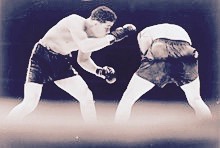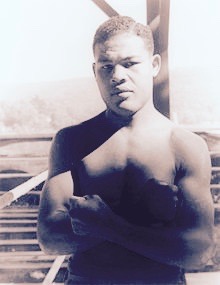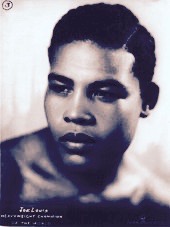Joe Louis: Louis vs. Schmeling I 1936

Joe Louis – America’s Hero Betrayed
Joe Louis
 Louis in 1941
Louis in 1941
Joseph Louis Barrow (May 13, 1914 – April 12, 1981), best known as Joe Louis and nicknamed the “Brown Bomber“, was an American professional boxer who competed from 1934 to 1951. He reigned as the world heavyweight champion from 1937 to 1949, and is considered to be one of the greatest heavyweights of all time. Louis’ championship reign lasted 140 consecutive months, during which he participated in 26 championship fights. The 27th fight, against Ezzard Charles in 1950, was a challenge for Charles’ heavyweight title and so is not included in Louis’ reign. Louis was victorious in 25 title defenses, a world record second only to Julio César Chávez with 27. In 2005, Louis was ranked as the best heavyweight of all time by the International Boxing Research Organization, and was ranked number one on The Ring magazine’s list of the “100 greatest punchers of all time.”
Louis’ cultural impact was felt well outside the ring. He is widely regarded as the first African American to achieve the status of a nationwide hero within the United States, and was also a focal point of anti-Nazi sentiment leading up to and during World War II. He was instrumental in integrating the game of golf, breaking the sport’s color barrier in America by appearing under a sponsor’s exemption in a PGA event in 1952.
Detroit’s Joe Louis Arena, home of the Detroit Red Wings of the National Hockey League, and the Forest Preserve District of Cook County’s Joe Louis “The Champ” Golf Course, situated south of Chicago in Riverdale, Illinois, are named in his honor.
Early life
 Louis in 1937
Louis in 1937
Born in rural Chambers County, Alabama (in a ramshackle dwelling on Bell Chapel Road, located about a mile off state route 50 and roughly six miles (10 km) north of Lafayette), Louis was the seventh of eight children of Munroe Barrow and Lillie (Reese) Barrow. He weighed 11 pounds (5 kg) at birth. Both of his parents were children of former slaves, alternating between sharecropping and rental farming. Munroe was predominantly African American, with some white ancestry, while Lillie was half Cherokee.
Louis spent twelve years growing up in rural Alabama, where little is known of his childhood. He suffered from a speech impediment and spoke very little until about the age of six. Munroe Barrow was committed to a mental institution in 1916 and, as a result, Joe knew very little of his biological father. Around 1920, Louis’s mother married Pat Brooks, a local construction contractor, having received word that Munroe Barrow had died while institutionalized (in reality, Munroe Barrow lived until 1938, unaware of his son’s fame).
In 1926, shaken by a gang of white men in the Ku Klux Klan, Louis’s family moved to Detroit, Michigan, forming part of the post-World War I Great Migration. Joe’s brother worked for Ford Motor Company (where Joe would himself work for a time at the River Rouge Plant) and the family settled into a home at 2700 Catherine (now Madison) Street in Detroit’s Black Bottom neighborhood.
Louis attended Bronson Vocational School for a time to learn cabinet-making.
 Louis vs. Schmeling I 1936
Louis vs. Schmeling I 1936
Conversely, Schmeling prepared intently for the bout. He had thoroughly studied Louis’s style and believed he had found a weakness. By exploiting Louis’s habit of dropping his left hand low after a jab, Schmeling handed Louis his first professional loss by knocking him out in round 12 at Yankee Stadium on June 19, 1936. To read more go to the link below.

